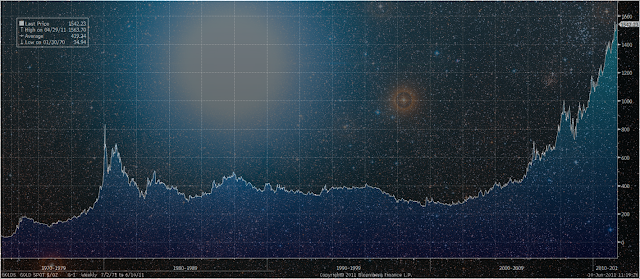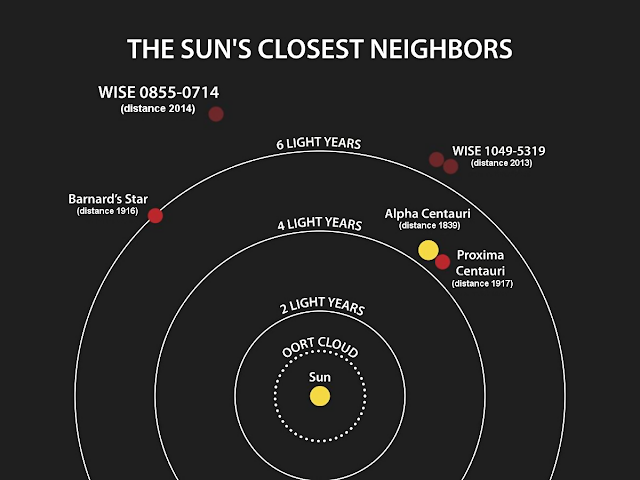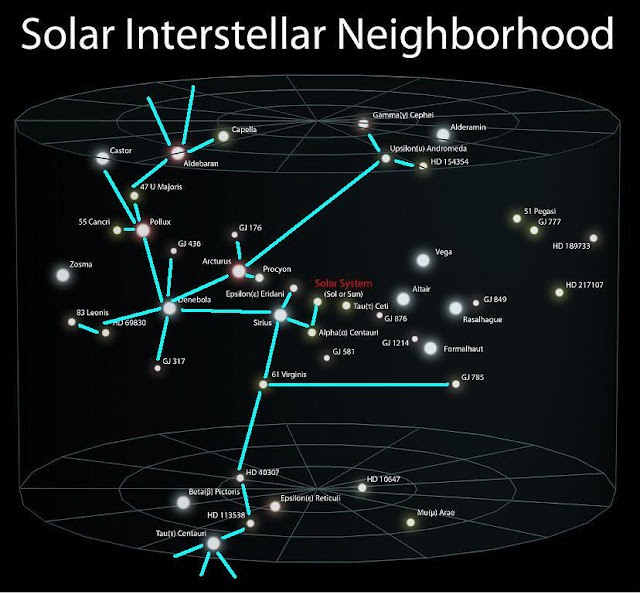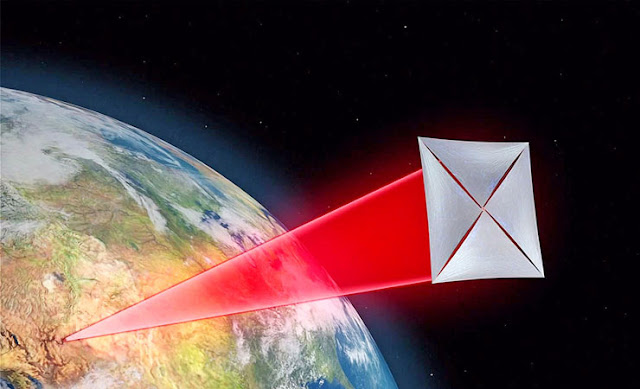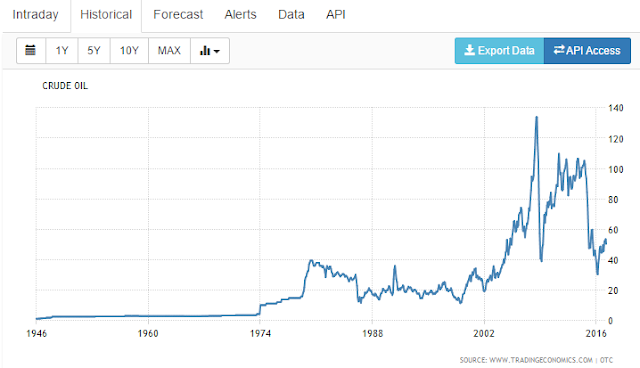A tough task
Travel between stars is hard. The distances are measured in trillions of kilometers and the space between destinations is not really empty. Attempting the crossing at interplanetary speeds is ludicrously slow; the only way is to reach velocities measured in percentages of the speed of light. Even then, travel times might measure decades to centuries.
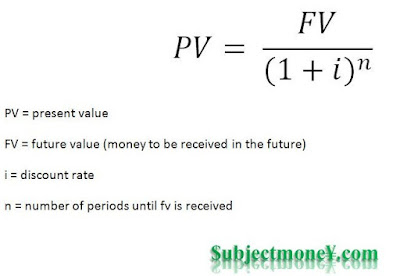 |
| How to calculate how much a 'promised' amount is worth today. Discount rate is how much the investor want to earn per year. |
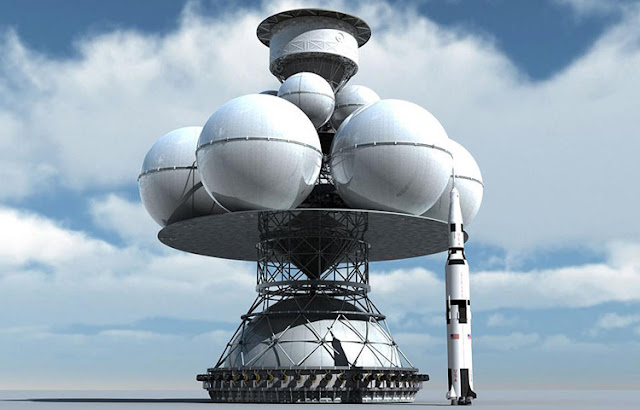 |
| Sorry, human travel to other stars will have to wait. |
At least, that is the common understanding of the matter. Here is another perspective.
Problem bounding
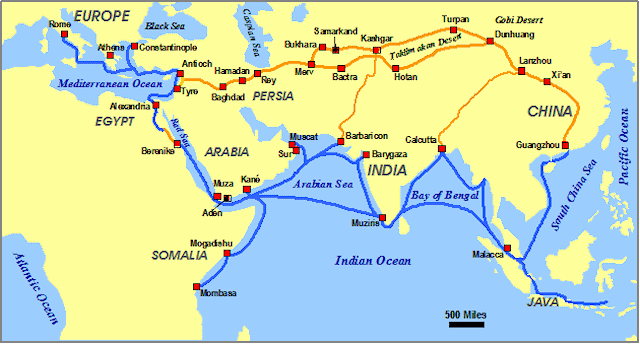 |
| Merchants willingly spent years on the Silk Road. |
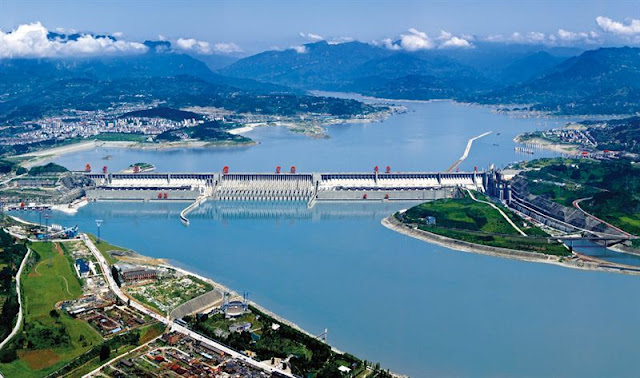 |
| 1.12km wide, 175m tall. |
Within this timescale, the spaceship must reach the target, conduct its activities and deliver goods.
Travel times
At 10% the speed of light, the relativistic effects are negligible and the kinetic energy equation (1/2*m*v^2) accurately describes the propulsive power required. However, the closer you get to the speed of light, the apparent mass of the spaceship will increase. This is described by the Lorentz Factor.
We also have to consider the Time Value of Money. Lowering the travel velocity lowers the initial cost but extends the duration of the trip. The longer the trip takes, the less the promised amounts of revenue are worth.
If you want to earn $1000 out of your $10000 investment next year, then your Required Rate of Return is 10%. If the investment takes 2 years, then you'd want 10000*1.1^2: $12100 in money back. Three years, and you'd want an extra $3310 instead of just $1000. In other words, the longer it takes to complete the trip, the more money that has to be promise to investors.
One way to reduce travel times is to fit bigger engines or use more powerful propulsion systems. This costs more money, right from the start. If you want to travel 20% faster, you might need a 20% bigger initial investment. An investor would have to put in $12000 instead of $10000. He'd want $3200 more after the first year, instead of just $1000.
A balance has to be struck between the motivation to reduce travel time and the larger up-front costs.
- Time cost of travel: RR ^ ((2 x Distance + CDT )/ Velocity)* Initial Investment
- Propulsion cost of travel: 0.5 * CJ * Mass * Lorentz Factor * Velocity ^2
Here is a simple example:
Imagine the fixed cost for the operation is 10 million units of currency. Distance is 5 light years. Spaceship is a laser sail of mass 1kg. Cost per joule 0.5 million units per terajoule (roughly running a 10GW laser for 1 month). RR is 10%. CDT is 1 year.
Using those equations, we find that the optimal velocity is 0.22C. For a ten times high initial investment, the optimal velocity is increased to 0.32C. For a ten times higher cost per joule, the optimal velocity is 0.16C.
The solution
If we want to go fast, we would need investors to accept huge up-front costs. If we want to go slow, investors will give up in favour of more immediate sources of income. On top of that, long travel times increase the chance of failure, such as radiation degrading electronics or collisions poking holes in the spaceship. Compensating for failures with a human crew rapidly makes the spaceship an Ark massing thousands of tons, possibly as expensive to launch as a fast probe.
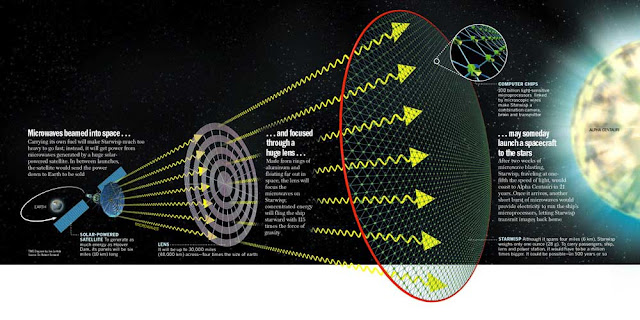 |
| The StarWisp concept. |
A tiny micro-spaceship is cheaper to accelerate to large fractions of C. Because it is small, we can afford to build many of them. Sheer numbers and short travel times compensate for the failure rate. There is also a hidden advantage: micro-spaceships can piggy-back on existing infrastructure or use off-the-shelf technologies. After all, investors are unlikely to wait through years of R&D and testing cycles before anything happens.
A small spaceship will reach the destination star-system, enter orbit and latch onto an asteroid or comet. It will use the resources available to build more copies of itself. Once a critical number of components is reached, it will start specializing the members of the 'colony' into roles such as energy collection, resource collection, communications, propulsion and so on. This colony continues to grow at exponential rates. It quickly reaches the size of the 'all-in-one' spaceship designs mentioned above, with similar functionality.
This ability to self-replicate and then specialize takes cues from the natural world. It can beat the time/velocity constraints set by traditional modes of interstellar travel.
How small are we talking?
A few grams at most! Three main versions could exist.
 |
| Binary fission of bacteria |
 |
| Bacteria forming 2D crystalline structures |
 |
| Bacteria forming honeycombs |
Nonetheless, the expansion of a gram-sized colony of replicators under favourable conditions taken an insignificant fraction of the interstellar travel time.
The second is based on micro/nano-technology. Very small machines contain all the data electronically. They are currently outside the reach of modern technology, but it is not a far stretch. They would be more vulnerable to damage than self-repairing bio-technologies, but are more efficient and develop faster on the same energy and resources than cells.
The third is theoretical atomic machines. Smaller than even nanomachines, these can manipulate matter at the atomic level. The advantage is that the 'spaceship' can be nothing more than a handful of molecules massing less than a milligram. The disadvantage is that it would be very difficult to store data on what the machines should do in a few molecules.
For the rest of this post, the cells or machines will be referred to as the 'seed'. This seed 'grows' and produces an 'ecosystem'. This ecosystem eventually returns products to the home system.
Examples of such an approach to interstellar travel do exist. Robert L. Forwards' StarWisp. It involves a 1 kilogram laser sail, propelled by microwaves to 10%c. Another is Geoffrey Landis's one-ton probe that uses a laser dish to power an ion engine to high exhaust velocities.
To return products to the home system, the ecosystem produces a replica of the propulsion method that propelled it in the first place, but at a larger scale and dedicated only to interstellar travel.
How it works
We will now look at the entire operation as a series of steps to take.
Step zero is to assess the current situation. As time goes on, humanity's economic, technologic and politico-legal status become more or less favorable for interstellar operations. They are best attempted when it is easy, affordable and profitable to do so.
The first step would be to find money for setting up the first operation. This is different from interstellar exploration, which would be funded mainly by governments and research bodies, and hampered by the fact that it is much easier to just build a bigger telescope than to send a probe to another star. Funding interstellar operations involves attracting investors and laying out a plan that produces tangible results at minimal cost and short timescales.
Next, the interstellar operation delivers the 'seed' to its destination. Interstellar travel is explored more in depth in the next part of this topic. This is the most 'hands-off' part of the interstellar operation. It ends when the self-replicating colony has grown to the point where it can divert resources to sending a signal back home.
The third step requires tough decisions to be made regarding the colony's future. With a several-year time lag, the investors can order the colony to concentrate on growing, on industrial production, on spreading across the system, on building a propulsion system to return products to the home system or sending copies of itself to other star systems. The tactics, strategies and competition the colony faces will be detailed in the third part of this topic.
The fourth step is critical. It involves receiving actual tangible products from another star system and turning a profit. How to do this and how it will affect the wider economy are critical.
In the case of a 10 year mission, we want returns higher than even the riskiest governments bonds, and equal to the corporate investment rates. This means a 10% return per year or better. If investors hand the company $10000, they want $25900 or more. This is not an extreme requirement, considering that the investors only send out a gram-sized seed and get back tons of rare elements on their doorstep at no extra cost.
Our situation
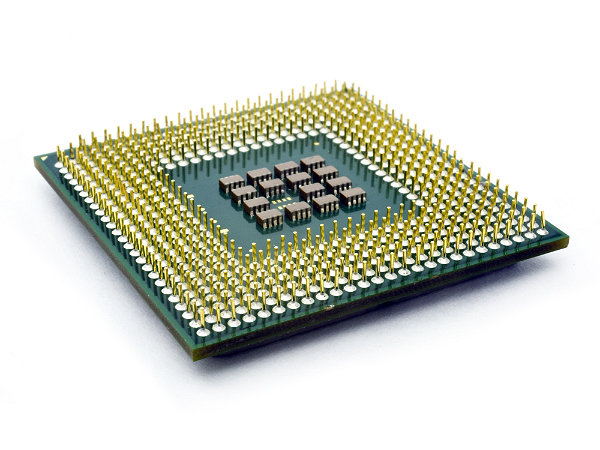 |
| Could we even fit a spaceship on something the size of a microchip? |
Nothing, absolutely nothing, that comes from another star system is cheaper than what can be extracted or made on Earth.
 |
| Schemes to build massive solar power stations to fund interstellar travel by selling electricity misinterpret the nature of Supply and Demand |
The development of more advanced technologies does not necessarily mean that a profit can be made on interstellar operations. Self-replicating seeds can be 'planted' right here on Earth to provide inexpensive exploitation of even the most recalcitrant mineral vein or most rarefied elements from air and oceans. Energy can be provided from uranium extracted from ocean-water uranium or orbital solar satellites using the same construction techniques required to build self-replicating colonies on other star systems.
Cheaper, more powerful propulsion technologies will open up the resources of the solar system before making interstellar travel accessible. At current rates, it will be tens of thousands of years before humanity lacks the raw resources to continue expanding. Whether it is the billions of tons of uranium, the trillions of tons of heavy and rare metals in asteroids and the practically infinite amounts of iron, silicon and carbon on the planets, our needs are covered!
But...
This is a false view of the realities of humanity's growth.
The energy and resource consumption rates are not being driven by population growth anymore; more precisely, they exceed what can be explained by larger populations. Developed countries are competing by producing for ever more energy-demanding markets, such as smartphone factories and computing. Developing countries are doing the same in voracious industries such as steel, bulk chemicals or food production. Today's 'under-developed' countries are starting their way up a mountain with an ever growing peak titled 'kWh per capita'.
 |
| The fastest growing economies are based on the most energy-intensive industries |
Coal and other fossil fuels have historically absorbed most of the increases in energy demand. Renewables (solar and wind) are the fastest growing energy sector. A significant portion of today's energy demand is produced by nuclear power stations. Efforts by the China Atomic Energy Authority are a major contributor to this development.
Will we have enough?
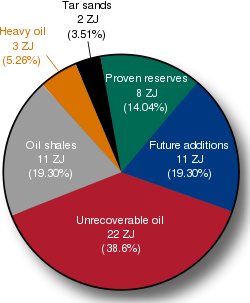 |
| Fossil fuel reserves in Zettajoules. 1ZJ powers a 100TW civilization for 31 years. |
Also, energy alone is a rather useless measure for our purposed. What matters is costs.
The cost of producing energy is related to the cost of making power stations. The billions of dollars required for a nuclear reactor or the thousands per solar kWh are an addition of material, financial, human and legal (insurance/safety) costs. All are variable except for material costs. We can be certain that these can only increase over time relative to the others. Whatever the production method, they cannot compensate for the fact that there will be less raw resources over time, held in deeper and harder-to-reach locations.
The most important of these raw resources are rarer elements, such as chromium for stainless steel turbines, cadmium in nuclear control rods, indium for solar panels. Many, such as copper, are majoritarily met by recycling.
Recycling allows us to forever have some production capacity, but it cannot compensate for increases in demand.
The next step is moving into space.
Solar power stations, rare elements mined from asteroids, lunar industries. We won't use them because we have completely run out of power or rare elements on Earth. We won't even wait for them to be significantly cheaper options than building another nuclear power station or platinum mine. No, they are viable as soon as they can make a better profit than their equivalents on Earth. Making a profit can be done at higher overall costs, through cheaper cost per ton or kWh output.
An example is oil. It cost on average $60 to $80 per barrel over the past ten years, despite the recently artificially lowered prices. It cost less than $10 per barrel 30 years ago, less than $3 dollar per barrel 50 years ago. Despite producing much more than before, the increased energy consumption and the fears of oil running out has made prices skyrocket.
This will happen to all energy sectors: wind, solar, nuclear... Even if the cost of increasing the surface area of a solar panel installation becomes dirt cheap, or if nuclear fuels become as widely available as gasoline, the price of electricity will still have to reflect the increasing value of rare metals and elements they are made of, and the cost of opportunity cost in covering arable land and habitable spaces with power stations.
But what about going interstellar?
In macroeconomics, there is the concept of the 'long run'. Simply, it is looking at industries and companies over time periods long enough that even fixed costs become variables.

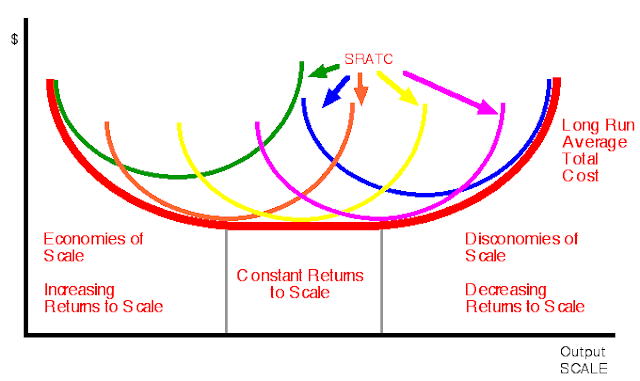 |
| Long Run Average Cost curves allow us to explore the concept of diseconomies of scale too. |
We know that the cost per kilo in orbit will fall. The cost per solar satellite kWh will become lower than the same kWh on the ground, because it will not have the same restrictions. The profit margin on space-based industries and interplanetary operations will increase. In the long run, the entire Solar System is one big competing economy where growth equals cheaper prices, due to economies of scale. It would not cost much more to invest in an asteroid mining operation than to build a lunar factory or send robots to Uranus, relative to the output.
But, even on the level of a Solar System, humanity will meet diseconomies of scale.
The number of asteroids with rare elements is limited. Mining planetary surfaces will reach profitability ceilings quickly, much faster than on Earth due to higher base costs. Advances in propulsion technology will help to match prices across the Solar System but only slow down the relative scaling of resource consumption.
So when will interstellar operations become viable? Is it when they start being profitable compared to opening up another mining operation on Venus or extracting tons of copper from an asteroid for the next solar power station?
Even earlier!
Property claims travel faster than rockets. The domains of states and nations travel faster than the speed of light! If, say in 100 years, the United States establishes an inhabited colony on Callisto, will it not claim the entire moon for itself? If China invests several billions in automated mining machines around Neptune and its moon Triton, and protects them with warships, will it not consider it part of its sphere of influence?
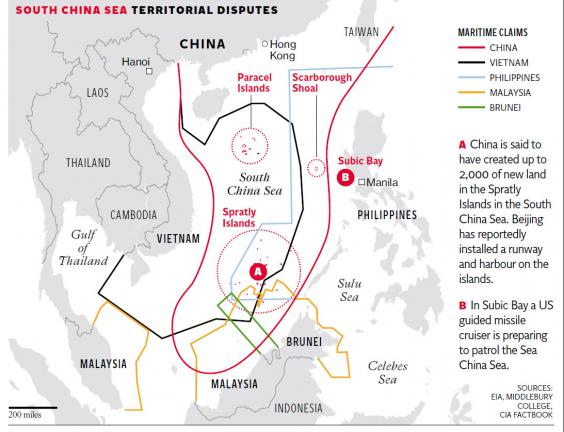 |
| Building artificial islands to secure your claim on the area sounds a lot like ringing space stations around the moon you're interested it. |
Depending on how the law is re-worded or clarified in the future, the entirety of the Solar System, out to the Oort cloud and the Kuiper belt will be divided between corporations, nations and states and 'owned', either as property, exclusive economic domain or through less legal bullying or loophole regulation enforcing. For example, if I shoot out a micro-sized spaceship, like the seed described above, at an icy Trans-Neptunian object, and turn it into a flying rocket fuel depot, I would have enough rights to the object and its use to prevent anyone else from settling a second colony on it.
This level of appropriation means that most of the Solar System can be 'tagged' by tiny spaceships, quickly, with the most powerful actors taking the lion's share.
How does this relate to interstellar operations?
Well, if the entire Solar System is owned by somebody or another, and the growth limits imposed by finite resources encourage state and private actors to bully new entrants out of the game, the only way is out.
A group of investors trying to beat the market in a fully owned Solar System will have a hard time trying to do so while paying rent and fees to existing market players. A company trying to expand vertically cannot fully control its suppliers. If a monopoly is put into place on a specific resource, it cannot be broken from the inside.
Nonetheless, these conditions might take centuries to appear. This is a difficult truth for science fiction writers, as all of technology, science, culture, social norms, politics and even languages change considerably. Trying to recreate their movements and still relating it to a modern audience is a very, very difficult task. Most of them want to write a story with a science fictional setting, not a setting where things happen. As reader, you want to learn the characters, not try to decipher the setting through the eyes of someone who finds it normal.
Making money
The interstellar operation's biggest variable, upon which depends profitability, cost and everything else, is time: time spent travelling to another star, time spent developing an industrial ecosystem, the time it takes to receive interstellar products.
Taking longer to complete objectives has to be compensated by higher or more reliable output. The output of an ecosystem set up in another star system is very likely to be proportional to the size of the colony and the fraction of its mass dedicated to non-replication roles. This means, that unless specific instructions are given to prioritize industrial production or colony expansion, the output will start small and increase quickly.
With the small initial output, it is best to prioritize what products are returned home. It has to be easy to make, so no complex microprocessors. It has to have a high value per kilo, as the output will depend on mass and the energy cost is fixed.
The first returns from an interstellar operation will be bulk quantities of the rarest elements. It will be whatever the Solar System was running out of when the seed was launched, whatever high-priced item that was expected to continue increasing in price.
| The ISV Venture Star is an example of an interstellar vehicle using a combination of lasers and nuclear engines. |
Later, larger quantities of material would need much bigger engines. It might not be feasible for a self-replicating colony that started out of a 1 gram mass of cells to produce reliable uranium centrifuges en masse a few months later. It would lack the ability to fuel up goods-laden spaceships for the a return journey. Accelerating them outwards can done with local solar-powered lasers and it becomes cheaper to build a laser around the Sun and brake the spaceships in the same way on our end. Discussion of interstellar travel methods in part 2 will cover the topic of returning products home.
As the products start returning home, and the interstellar operation starts making outrageous profits by breaking monopolies or crashing price bubbles on scarce resources, a certain dynamic process has to be initiated to continue making profits.
This process is the slow communications between the investors and the seed colony. Communications are done at light speed, so it takes between 4.2 to 12 years for a message to arrive at the colony. The same delay is required for a 'message read' confirmation to return.
What do the investors do with these communications?
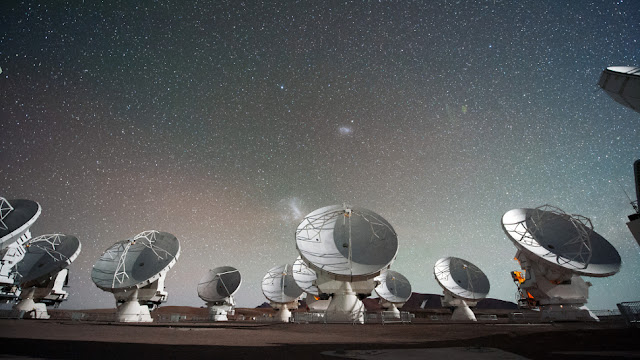 |
| Everyone hears the colony's signals... but it might be encrypted. |
New information can be sent, allowing the colony to follow technological trends and continue producing relevant components. When the highest value asteroid resource of the colony's star system are nearing exhaustion, investors might point the colony towards the planetary bodies. It would have grown large enough to compensate for the energy cost of moving supplies up and down the gravity well. The reward would be elements that are rare even on asteroids, such as uranium and other fissile fuels. Some industrial processes require gravity, other are extremely polluting to the environment or plain unacceptable on inhabited surfaces. These can performed without care.
The difficulty would lie in anticipating the market trends and compensating for its movements in expectation of an interstellar delivery. For example, if indium is in demand, its price might drop in response to an interstellar colony announcing a delivery of several thousand tons of it. The investors can try to trick the market by labelling the delivery as something else. Or, they could have looked ahead and understood that indium flooding the market would make solar panels cheaper to make, which actually increases demand for selenium. So they sent instructions to the colony 4 years ago to closely follow up the delivery of indium with a big ball of pure selenium 20m across.
Thankfully, trends over 4-12 years are considered 'long term'. They move much more slowly than spot prices. Their volatility is further reduced by the fact that interstellar operations deliver products at a rough price of zero above amortisation and product recovery cost.
Since the useful life of an interstellar operation is nearly infinite, and it can boosted every few years with new seeds like a shot of corrective vaccine, the amortisation cost is purely arbitrary. The recovery costs are drawn from the profits made from the deliveries. Since the majority of these costs are spaceships that go and dock with the payload or an array of lasers that brake it into the solar system, they can be considered investments. The operation is investing in an increased capacity for handling larger payloads.
An investment model
Do the investors sit doing nothing in between payload deliveries? Are physical products the only thing they have to sell?
Not at all!
In a modern economy, the investors will be able to make money before the first signal arrives from the colony and have profits that far exceed their sales revenue.
Bonds, futures and intangible assets are vital to an interstellar operation.
First of all, consider the steps involved in mounting an interstellar operation. While many will hear of the attempt, only a fraction of people will have money available for investing in the project. A small percentage of those people will actually put money on the table.
Will that percentage not increase once the probe is on its way? Will it not increase with every year the seed spends in space not getting destroyed? Will the number not explode once an 'A-OK' signal arrives from another star?
Attracting investors and obtaining their money by selling shares in the company is called equity financing. When the interstellar operation shoots out its first spaceship, it can perform an IPO and become a publicly traded company on the wave of news hype. As good news arrives, it issues shares and sells them at increasing prices. Debt funding, which is taking out loans for a bank, is not recommended here as the company does not have the cash to pay back interest. Equity investors, now called shareholders, can be asked to wait for the first dividends.
Basically, the company can make money out of pure hype. This is similar to how tech start-ups operate.
The second source of income, before any product has arrived, is data. Beyond instructions and reports, investors in the interstellar operation have no need of the data sent back by the colony. It costs nothing, however, to keep the dishes transmitting scientific and prospecting data. This data is sold to research bodies such as Universities for an additional revenue stream. The company might even convince a University to divert some of its astronomy budget towards helping the company along, in return for guarantees on delivering future data.
Another source of income is futures. These are agreement where the client agrees to buy a certain quantity of a certain product from the supplier at an agreed-upon price, in the future. The client pays now, and receives the products later. There are variations, such as the client allowing themselves to buy less than the expected amount, or the supplier offering prices that change with the future market, but the principle is the same: I get money now for something I'll do in the future.
In the case of an interstellar operation, investors can sell portions of their expected output to interested clients, and gain money in return. The clients will be happy that they'll get products at lower-than-market or even post-crash prices, while investors are happy to get money in return for something that cost them nothing to deliver.
Futures are involved in every step of the operation, from selling and negotiating the price of products during the long journey back home, to trading in percentage outputs of the entire colony for the next 100 years.
After the first delivery has arrived, there are many money-making opportunities for the operation's investors.
They can set up an artificial scarcity, where the massive amount of items delivered are sold slowly, over time, at higher prices than just dumping them in the market. They can offer specific items at the clients' demand in the next delivery, at a premium. Using their demonstrated success, they can ask for funding towards a second interstellar operation, headed towards another star system.
These will take the form of bonds. A certain amount of money is contracted towards the operation, to be returned at a future date. In the mean time, the interstellar company pays out interest. This interest is equal to the client's Required Rate of Return, and is called a coupon payment.
 |
| Low returns on government bonds makes corporate bonds attractive. |
If multiple product deliveries succeed, the first clients that bought Interstellar Bonds will sell their contracts on the bond market, known as the secondary debt market. Successive high-profit events, such as the delivery of tons of rare material, are extremely useful for increasing the value of bonds. Once the bond price has reached a certain level, the operation can issue new bonds, at higher face values (contracted initial amounts) and lower coupon rates, and still be popular. A consistently well-performing bond market can become the company's primary source of revenue!
The company can also offer indefinite bonds, which pay out a consistent 'rent', or short-term bonds just before a payload arrives.
As mentioned above, the company is not limited to how much profit it makes off selling physical products. It can sell intangibles such as growth.
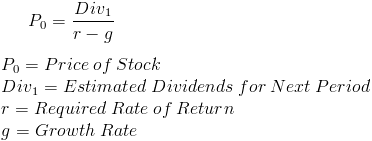 |
| The Dividend Discount model for stock valuation. More growth means more valuable stock. |
This can go even further.
Imagine it puts 1% of its profits towards a 'Second Interstellar Seed' fund. That 1% could open up an entire star system, with an entirely new stream of revenue. The actual value of the fund is dwarfed by its potential value... but what does the company sell? It sells potential value, of course.
Summary
Human travel to the stars is not going to be possible for a very long time due to the deltaV requirements. A small 'seed' of self-replicating components can cheat the rocket equation.
The seed produces a colony through exponential growth. A portion of the components are specialized into various units with specifc roles. Eventually, it can start exploiting local resources to send valuable products back to Earth.
Interstellar operations need the following three criteria to happen:
-A sufficient technological basis for fraction-C travel and reliable self-replicating machines (Realisable)
-A growth in resource consumption that increases costs to the point where interstellar alternatives are viable and/or (Profitable)
-An interplanetary presence and a Solar System closed to newcomers or legally or de-facto hostile to free-for-all investment makes such investments necessary (Affordable)
These conditions might take several centuries or more to come together. Having the technological ability to travel to other stars is not a guarantee of regular interstellar travel. Not having enough resources to continue growing will not push humanity to the stars, but into space, the asteroids and the moons of our Solar System.
The best method of considering interstellar travel is from a financial and economic standpoint. We do not invest in projects because we can or because we want to, but because they are better to the existing alternatives.
Money can be made from interstellar travel before a single kilo of precious metal is sold on the markets. Financial products can allow a company that invests in interstellar operations to produce a cash flow greater than just what is sold on the market, by selling intangibles such as rights, data, growth and investor confidence. By looking at interstellar operations as just another investment model that justifies the set-up cost with huge profit margins, we can realistically fit it into a setting where humanity has not yet left the solar system.
